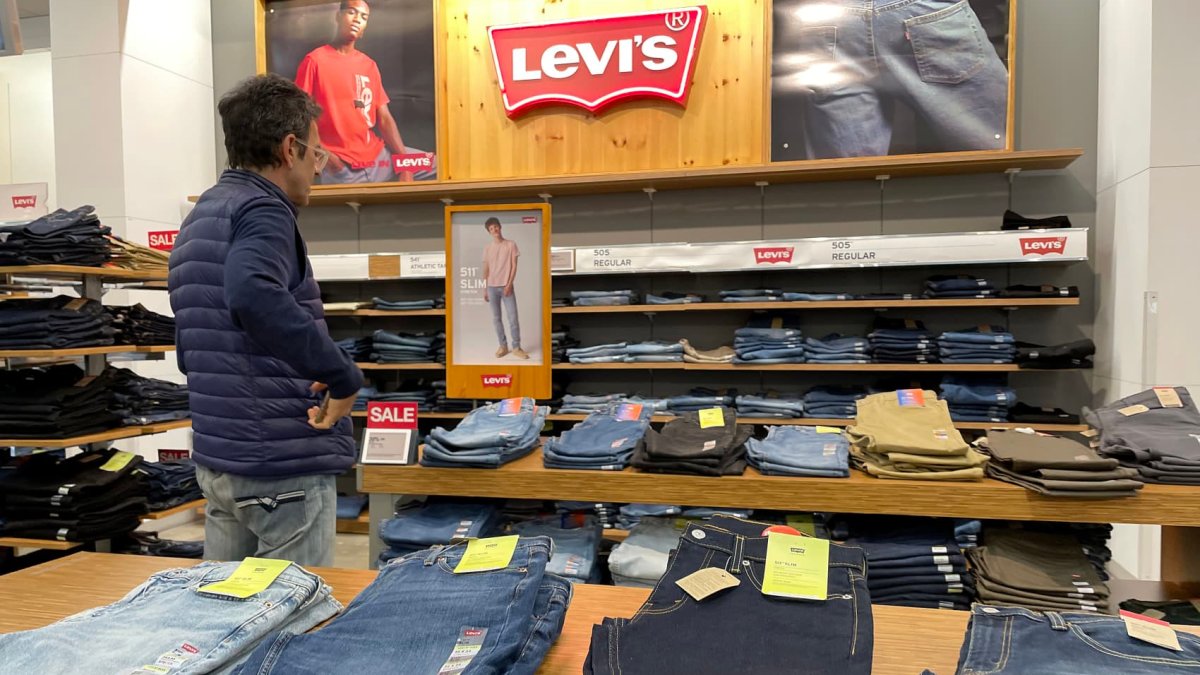- Levi Strauss delivered mixed quarterly results and said it was looking to sell its Dockers business.
- The jeans maker is seeing strong gains in its namesake brand and Beyond Yoga, but sales at Dockers fell 15% during the quarter.
- Levi’s focus on direct sales, plus lower cotton costs, saw its gross margin increase 4.4 percentage points.
Jeans-crazy consumers are turning to Levi Strauss & Co for new jeans, but the company’s overall business is being dragged down by its Dockers brand, which the company is now considering selling, it announced on Wednesday.
Sales at the Levi’s brand rose 5% during the fiscal third quarter — the biggest gain in two years — but overall revenue came in flat and lower than Wall Street expected.
Shares of Levi’s fell more than 8% in extended trading on Wednesday.
Here’s how the jeans maker performed compared to Wall Street’s expectations, based on a survey of analysts by LSEG:
- Earnings per share: 33 cents adjusted vs. 31 cents expected
- Income: $1.52 billion vs. $1.55 billion expected
The company’s reported net income for the three-month period ended Aug. 25 was $20.7 million, or 5 cents per share, compared with $9.6 million, or 2 cents per share, a year earlier. Excluding one-time items, Levi’s posted earnings of $132 million, or 33 cents per share.
Sales totaled $1.52 billion, up slightly from $1.51 billion a year earlier.
With one quarter left to go in the fiscal year, Levi’s reaffirmed its full-year adjusted earnings per share guidance of $1.17 to $1.27, in line with expectations of $1.25, according to LSEG. It expects earnings per share to come in between that range.
It cut its revenue guidance and now expects sales to rise 1%, compared with a previous range of between 1% and 3%. This is below the 2.3% increase that analysts had expected, according to LSEG.
So long, Dockers
Levi’s, which owns its namesake brand as well as Dockers and Beyond Yoga, would have printed a different set of results if not for Dockers. She started that brand in 1986 to offer consumers an alternative to jeans: khaki.
Throughout the 1990s and 2000s, khakis were a mainstay in most consumers’ closets, but these days, it has fallen out of fashion. The efforts Levi’s has made to differentiate Dockers led to too much overlap with the Levi’s brand, which has expanded into a lifestyle brand that offers much more than jeans.
During the quarter, sales at Dockers fell 15% to $73.7 million, while Beyond Yoga, the active sports brand it acquired in 2021, saw sales rise 19% to $32.2 million.
“Over the past two years, the brand has underperformed. … We felt this was the right decision for the long term. Our view financially is that the exit of Dockers will improve the company’s overall margins and also minimize volatility in top line growth.” Levi’s chief financial officer Harmit Singh told CNBC in an interview. “We believe Dockers’ exit will allow Dockers and Levi’s to operate independently and maximize each other’s value independently.”
Levi’s used Bank of America to lead the sale process.
Direct earnings
Beyond Docker’s, Levi’s is making gains in increasing its profitability as it continues to shift its focus to direct-to-consumer sales.
During the quarter, its gross margin increased by 4.4 percentage points, which Singh attributed to the direct selling strategy, lower cotton costs and better products that did not need to be marked up to sell.
Like other brands, Levi’s has worked to create its direct sales strategy and reach more customers through its stores and websites rather than through wholesalers like Macy’s. The strategy is a boon to profits because margins are higher and it also allows brands to get closer to their customers through data collection.
During the quarter, Levi’s direct channel grew about 10%, driven by strength in the US and 16% growth in e-commerce. Overall, direct sales accounted for 44% of total revenue, and Levi’s wants to bring that number closer to 55%.
Behind those numbers are a series of marketing campaigns, which include a new partnership the jeans brand announced with Beyoncé on Monday after the pop star released a song titled “LEVII’S JEANS” earlier this year on her country album.
“Our strategic decision was to actually have Beyoncé represent some of our core products. So in the first ad, the first chapter, she’s in … 501s and a basic white T-shirt and there’s no more Levi’s than that. ” CEO Michelle Gass told CNBC. “Part of the recipe for success for Levi’s has been and will continue to be us living at the center of the culture and merging the icon of Beyoncé with the icon of Levi’s, I don’t think there’s a better example of that.”
Global difficulties
Sales at Levi’s Europe business came in higher than expected at $406.6 million, ahead of StreetAccount estimates of $392 million, but sales in the Americas and Asia were lower. Levi’s posted $757.2 million in U.S. sales, below the $789.2 million that StreetAccount analysts had expected. In Asia, Levi’s saw revenue of $247.1 million, below StreetAccount estimates of $258 million.
“China was a stumbling block,” Singh said of the region, which represents about 2% of Levi’s overall business. “There’s a macro issue and we had some execution issues. We’ve just changed leadership in China and over time we still believe in China’s long-term potential.”
In the Americas, beyond a slowdown at Docker’s, sales were also impacted by one of Levi’s largest wholesale customers in Mexico, Singh said. During the quarter, the partner experienced a cyber security breach, which limited shipping times and impacted sales. The region is also working on some “execution issues,” Singh said.
